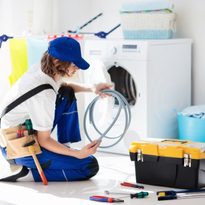
Top load washers are a staple in many households, offering convenience and efficiency in laundry care. Understanding how to troubleshoot and repair common issues can extend the lifespan of your appliance and save you money on costly repairs or replacements.
One of the most common problems with top load washers is water leakage or overflow during the wash cycle. This can be caused by a variety of factors, including damaged hoses, faulty water inlet valves, or worn seals.
Unusual noises such as grinding, banging, or squealing during operation are often indicative of underlying issues with the washer’s components. These may include worn bearings, loose belts, or foreign objects trapped in the drum.
If your washer fails to spin or agitate properly, it may result in clothes that are not thoroughly cleaned or rinsed. This could be due to a malfunctioning drive belt, worn motor coupler, or issues with the transmission.
A washer that doesn’t drain properly can leave clothes soaked and cause potential damage to the appliance. Clogged drain hoses, a faulty drain pump, or issues with the lid switch can contribute to this problem.
Many modern top load washers are equipped with error code systems to help diagnose problems. Understanding these codes and their meanings can expedite the troubleshooting process and facilitate repairs.
Start by inspecting the drain hose and pump for any obstructions that may be impeding the flow of water. Clearing away debris and buildup can often resolve drainage issues.
The lid switch plays a crucial role in ensuring the washer operates safely and efficiently. A faulty lid switch can prevent the washer from starting or cause it to stop mid-cycle.
A worn or damaged drive belt can affect the washer’s ability to spin or agitate properly. Check for signs of wear and tear, such as fraying or cracking, and replace the belt if necessary.
The water inlet valve controls the flow of water into the washer during the wash cycle. If it becomes clogged or malfunctioning, it can result in issues such as inadequate water supply or leakage.
If the drive belt is worn or broken, it will need to be replaced. Refer to your washer’s manual or online guides for step-by-step instructions on how to safely remove and install a new drive belt.
Replacing a faulty water inlet valve requires basic plumbing skills but can typically be completed within an hour or two. Be sure to disconnect the washer from power and water sources before attempting any repairs.
A clogged or malfunctioning drain pump can impede water drainage and lead to various issues. Cleaning the pump filter or replacing the pump assembly can restore proper functionality to the washer.
Uneven or unstable washer operation may indicate that the leveling legs need adjustment. Use a bubble level to ensure the washer is properly balanced and adjust the legs as needed to prevent rocking or vibration.
For complex repairs involving electrical components or structural issues, it’s best to seek the assistance of a qualified technician to avoid injury or further damage to the appliance.
Issues such as faulty control boards, wiring problems, or motor issues may require specialized knowledge and tools to diagnose and repair effectively.
If your washer is showing signs of significant wear and tear, such as rust, corrosion, or damaged components, it may be more cost-effective to replace the appliance rather than attempting extensive repairs.
Routine maintenance, such as cleaning the drum, detergent dispenser, and filter, can help prevent issues such as mold, mildew, and odor buildup.
Avoid overloading the washer, using excessive detergent, or washing items that are not suitable for the machine to prolong its lifespan and optimize performance.
Schedule periodic servicing by a qualified technician to inspect and maintain critical components of the washer, ensuring it operates safely and efficiently for years to come.
Maintaining a top load washer doesn’t have to be a daunting task. By understanding common issues, troubleshooting tips, and when to seek professional help, you can keep your appliance running smoothly and efficiently for years to come.

Comments (10)
I was impressed by how quickly Bit Appliance Repair fixed my washer dryer. Highly recommend their service!
I was blown away by the level of professionalism and expertise displayed by their technicians during my recent washer dryer repair service. Not only did they fix the issue quickly and efficiently, but they also provided helpful tips for maintaining my appliances in the future. I'm incredibly impressed and grateful for their excellent service!
Thank you, Bit Appliance Repair, for saving the day with your efficient washer dryer repair. Couldn't be happier!
Kudos to Bit Appliance Repair for their prompt and reliable washer dryer repair. They're definitely my go-to!
I was blown away by the level of professionalism and expertise displayed by their team during my recent washer dryer repair service. Not only did they fix the issue quickly and efficiently, but they also provided helpful tips for maintaining my appliances in the future. I'm incredibly impressed and grateful for their excellent service!
Bit Appliance Repair exceeded my expectations with their same-day washer dryer repair service.
I recently had the pleasure of using their washer dryer repair service, and I couldn't be happier with the experience. Their technicians were friendly, courteous, and incredibly skilled, and they had my appliances fixed in no time. Their attention to detail and commitment to customer satisfaction are truly unmatched. I highly recommend their services to anyone in need of appliance repair.
Their washer dryer repair service exceeded all my expectations. Their technicians were professional, courteous, and knowledgeable, and they went above and beyond to ensure that my appliances were working perfectly. I'm incredibly impressed with their level of expertise and would definitely use their services again in the future.
Bit Appliance Repair's same-day service saved me from a laundry nightmare. Thank you for your swift repair!
Highly satisfied with Bit Appliance Repair's same-day service. My washer dryer is running smoothly again!